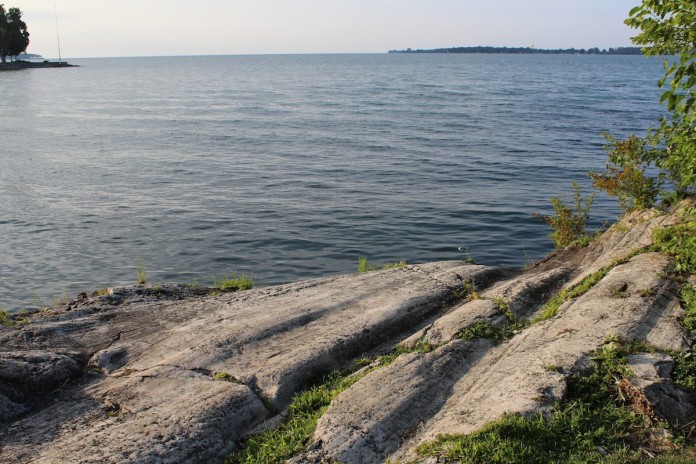SALEM, Ohio — Companion bills, dubbed the Clean Lake 2020 Plan, were introduced into the Ohio Senate and Ohio House of Representatives in early May that would invest significant funds to protect Lake Erie water quality.
Both chambers have also proposed a $1 billion Clean Water Ohio bond issue that would appropriate $100 million per year for 10 years, if approved by Ohio voters in the fall.
House Bill 643, cosponsored by Reps. Steve Arndt, R-Port Clinton, and John Patterson, D-Jefferson, and Senate Bill 299, cosponsored by Sens. Randy Gardner, R-Bowling Green, and Sean O’Brien, D-Bazetta, have both received supporting testimonies within their respective committees.
This week, the senate passed SB 299, which will now move to the Ohio House of Representatives for their consideration. HB 643 awaits a committee vote to move forward.
Related: Ohio lawmakers review fertilizer bill
Lake Erie water quality has been an ongoing public health concern, particularly following record-setting harmful algal blooms in 2011 and 2015, triggered by cumulative phosphorus loading. Toxins from a bloom in 2014 led to a three-day “do not drink tap water” advisory for half a million people in Toledo and the surrounding area.
What’s included
If approved, the two bills would:
• Invest as much as $20 million in capital funds in farm equipment and other initiatives to reduce phosphorus runoff in the Western Lake Erie Basin.
• Invest $10 million to prevent open lake dumping of dredged materials in Lake Erie.
• Invest $2.65 million in the Ohio State University Sea Grant’s Stone Laboratory near Put-in-Bay to pay for research lab space and monitoring devices.
• Invest $3.5 million to support the conservation efforts of the soil and water conservation districts in the Western Lake Erie Basin.
Proactive
“We’re definitely concerned with water quality and we are trying to be proactive,” said Rep. Patterson.
He said the idea is to assist Soil and Water Conservation Districts by getting more boots on the ground for conservation projects and provide funding for water quality research at Ohio State Sea Grant’s Stone Laboratory.
“We have a phosphorus issue in the west end of lake. In central and southern Ohio, we have a nitrate issue,” he said.
“We want to get out ahead of both of these, too, before federal intervention.”
John Torres, director of government and industry affairs at the Ohio Corn and Wheat Growers Association, echoed this sentiment, saying the commodity group has been collaborating on these bills to prevent any potential government mandates that would be costly to an already struggling farm economy.
“The voluntary work farmers have been doing in the western basin is good, but we are limited in funding,” said Torres.
The association would like to see more incentives, like cost-sharing opportunities between farmers and the state, that promote good farming practices.
Proponent
So far, the Ohio Corn and Wheat Growers Association, Ohio Soybean Association, Ohio Farm Bureau, the Nature Conservancy of Ohio, Ohio Environmental Council, Lake Erie Foundation, the Ohio Manufacturers Association, the County Commissioners Association of Ohio, the City of Conneaut, several livestock commodity groups and the Wood and Ottawa soil and water conservation districts have testified in support of the bills.
There has been no opposition testimony to date.
Concerns
Joe Logan, president of Ohio Farmers Union, expressed some concerns regarding the funding source of the two bills.
“We like the intent (of the two bills), but we have concerns about taking money from the state parks to make ag infrastructure improvements.”
Logan said OFU is currently reviewing the twin proposals, but have not taken an official position.
“More conservation is definitely needed in the Western Lake Erie Basin and if we can derive some funding to help farmers defray cost, we are on board,” said Logan.
Funds
Both bill summaries state equipment for the protection and preservation of Lake Erie can be purchased with proceeds from the existing Parks and Recreation Improvement Fund. Logan suggested making a small increase to farmers’ fertilizer fees would also help generate the funds needed.
“We wouldn’t rob Peter to pay Paul and farmers would scarcely notice the increase.”
Logan said Ohio Farmers Union may testify as an interested party, urging legislature to seek other funding sources.
For my farm
The Ohio Corn and Wheat Growers Association and the Ohio Soybean Association have created a website that shows how farmers have been using best practices and good stewardship to prevent runoff from their farms.
“The notion that they haven’t been doing anything is false,” said Brad Reynolds, director of communications at Ohio Corn and Wheat.
The website, formyfarm.com, includes videos and interviews with farmers talking about their farm practices and the benefits of using best management practices.
“This website was really designed to help show farmers are doing things.”










